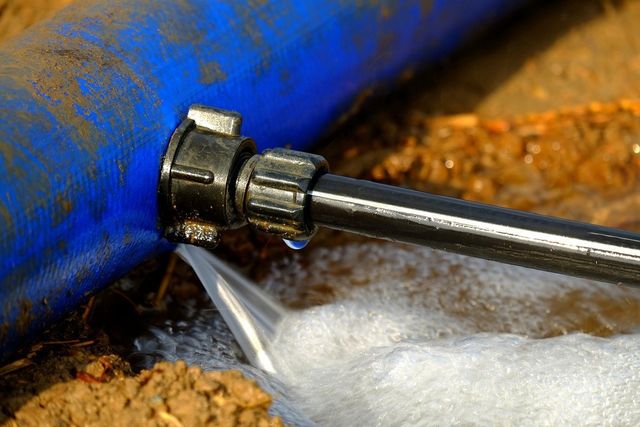Overview To Water Leak Detection In The House
Overview To Water Leak Detection In The House
Blog Article
What're your concepts about Locating water leaks?

Early discovery of leaking water lines can alleviate a prospective disaster. Some tiny water leaks might not be noticeable.
1. Check Out the Water Meter
Every residence has a water meter. Inspecting it is a surefire manner in which assists you discover leakages. For beginners, shut off all the water sources. Make certain nobody will purge, use the tap, shower, run the washing equipment or dishwashing machine. From there, go to the meter as well as watch if it will alter. Since nobody is using it, there need to be no movements. That suggests a fast-moving leak if it moves. If you find no modifications, wait an hour or two and also inspect back once more. This implies you may have a slow-moving leak that can even be below ground.
2. Inspect Water Intake
If you spot unexpected changes, in spite of your intake being the exact same, it means that you have leaks in your plumbing system. An abrupt spike in your bill suggests a fast-moving leakage.
Meanwhile, a stable rise every month, even with the exact same routines, reveals you have a slow-moving leak that's also slowly rising. Call a plumber to extensively examine your home, particularly if you feel a warm area on your flooring with piping below.
3. Do a Food Coloring Test
When it comes to water usage, 30% comes from bathrooms. If the color in some way infiltrates your bowl during that time without flushing, there's a leak between the container as well as bowl.
4. Asses Exterior Lines
Don't forget to check your outdoor water lines too. Test faucets by attaching a yard hose pipe. Needs to water leak out of the link, you have a loose rubber gasket. Replace this and make sure all connections are limited. It will aid obtain it expertly took a look at and also maintained every year if you have actually got a lawn sprinkler system. One tiny leakage can throw away tons of water and also surge your water costs.
5. Evaluate and also Assess the Scenario
Property owners should make it a habit to check under the sink counters and even inside closets for any type of bad odor or mold growth. These 2 warnings suggest a leak so prompt attention is needed. Doing routine inspections, also bi-annually, can save you from a significant problem.
Examine for discolorations and damaging as many appliances and pipelines have a life expectancy. If you believe dripping water lines in your plumbing system, do not wait for it to intensify.
Early discovery of leaking water lines can reduce a possible catastrophe. Some little water leaks may not be visible. Inspecting it is a guaranteed method that helps you find leakages. One little leakage can waste bunches of water and spike your water expense.
If you believe leaking water lines in your plumbing system, do not wait for it to intensify.
How to Know If Your Home Has a Hidden Leak
Water Meter Reveals Inexplicable Water Usage
If you’d like to test whether or not there’s a leak somewhere in your home, you can do this using your water meter. Here is how to conduct the test:
Don’t use any water in your home for at least 30 minutes; this also means not turning on faucets or water-using appliances.
Go outside, and check your water meter for activity.
If your water meter shows that there was activity, even though no one was using any water, this proves that there is a leak in your home.Visible Mold or Mildew Growth
Leaks behind walls create moist, dark environments that allow mold and mildew to grow and thrive. Eventually, you might see mold growth forming on the wall closest to a hidden leak.
If mold is growing in an area that receives a high amount of moisture, such as a bathroom, it may simply be an indication that better ventilation is needed. However, if you see mold growth on a wall or the ceiling in an area where you would not expect, you probably have a hidden leak.
Musty, Mildew Odor
Sometimes you might not be able to see the mold or mildew that is growing as a result of a leak. However, the smell can give the problem away just as easily. If you catch a whiff of something musty, there’s a good chance that old water is collecting somewhere in your home that you can’t see.
Stained/Warped Walls, Ceilings, or Floors
When your home soaks up water, a variety of red flags can become visible, including ceiling stains, bubbling drywall, warped walls, and sagging floors. While these issues can be caused by excess humidity, they can also be signs that a pipe or plumbing connection has started leaking behind your walls.
Inexplicably High Water Bill
After a while, you get a general sense for what your water bill should be. If you own a pool or sprinkler system, your bill will tend to be higher during summer. However, if you receive a water bill that seems especially high, and you can’t figure out what caused it, then you may have a hidden leak somewhere that’s increasing your bill.
https://www.plumbingjoint.com/blog/2019/july/how-to-know-if-your-home-has-a-hidden-leak/

Do you like reading about Leaking water lines? Make feedback further down. We would be glad to see your insights about this write-up. We hope that you visit us again later on. In case you enjoyed our blog entry please be sure to pass it around. Thank you for taking the time to read it.
Report this page